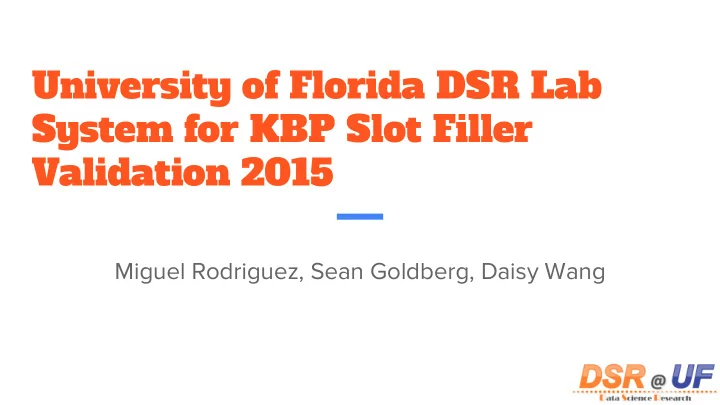

University of Florida DSR Lab System for KBP Slot Filler Validation 2015 Miguel Rodriguez, Sean Goldberg, Daisy Wang
Slot Filler Validation Bristol Central High School gpe:schools_atended New England Patriots University of Florida University of Connecticut ABC News Tim Tebow
Slot Filler Validation Truth Bristol Central High T School gpe:schools_atended New England Patriots F University of Florida T University of F Connecticut ABC News F Tim Tebow
Slot Filler Validation Truth Survey Research T Center org:subsidiaries Florida Museum of T Natural History Smithsonian Tropical F Research Institute
Slot Filler Validation - Classification ● Slot Filler Validation is a binary classification task ○ Given a set of queries consisting of tuples of the form <entity, slot> And a set of Slot Fillers for each query ○ Determine if a slot filler is True or False ○
Slot Filler Validation - Classification ● Slot Filler Validation is a binary classification task ○ Given a set of queries consisting of tuples of the form <entity, slot> And a set of Slot Fillers for each query ○ Determine if a slot filler is True or False ○ ● A CSSF output is the output of such classifier ○ Ideal for ensemble classification ○ Aggregate the output of multiple classifiers Outperform the original ones ○
Ensemble Classification ● Ensemble methods have two main parts ○ Inducer : Selects the training data for each individual classifier ○ Combiner : takes the output of each classifier and combine them to formulate a final prediction
Stacked Ensemble Meta-level classifier that takes the output of other models as input and estimate their weights Vidhoon Viswanathan, Nazneen Fatema Rajani, and Yinon Bentor Raymond J Mooney. 2015. Stacked ensembles of information extractors for knowledge-base population. In Proceedings of the 53rd annual meeting on association for computational linguistics. Association for Computational Linguistics
Stacked Ensemble ● Requires labeled data ○ Available from 2013 and 2014 SF and SFV ● Training Strategy Learn from previous year performance ○ 2013-2014: 7 teams ○ ○ 2014: 12 teams
Stacked Ensemble ● Requires labeled data ○ Available from 2013 and 2014 SF and SFV ● Training Strategy Learn from previous year performance ○ 2013-2014: 7 teams ○ ○ 2014: 12 teams ● All runs that can not be fit into the classifier are discarded! ○ Leave out extra evidence … From potentially well ranked systems ○
Stacked Ensemble - not enough! Rank TEAM ID 0-HOP 1-HOP ALL Rank TEAM ID 0-HOP 1-HOP ALL F1 F1 F1 F1 F1 F1 9 SFV2015_SF_03_1 0.3457 0.1154 0.2718 39 SFV2015_KB_10_1 0.1834 0.0952 0.1474 14 SFV2015_KB_16_2 0.2633 0.1655 0.2247 45 SFV2015_KB_09_1 0.0965 0.0791 0.0899 16 SFV2015_SF_18_1 0.292 0.0972 0.2245 47 SFV2015_SF_13_2 0.1225 0 0.0892 24 SFV2015_SF_08_4 0.2669 0.0976 0.2102 56 SFV2015_SF_07_1 0.0512 0 0.0353 31 SFV2015_SF_02_1 0.1883 0.1299 0.1649 63 SFV2015_KB_11_1 0.019 0 0.0121 34 SFV2015_SF_06_1 0.2351 0 0.1595 64 SFV2015_SF_17_1 0.019 0 0.0121 F1 score ranking of 2014-2015 teams.
Consensus Maximization Fusion Augment stacked ensemble model by adding more meta-classifiers
Consensus Maximization Fusion Add runs that can not fit into the stacked ensemble method. We treat these runs as 2-Class Clusters
Consensus Maximization Fusion Jing Gao, Feng Liang, Wei Fan, Yizhou Sun, and Jiawe Han. 2009. Graph-based consensus maximization among multiple supervised and unsupervised models. In Advances in Neural Information Processing Systems, pp 585–593.
Consensus Max. Fusion - Example ● Consider the following queries ○ O1 = (Marion Hammer, per:title, president) O2 = (Dublin, gpe:headquarters_in_city,trinity college) ○
Consensus Max. Fusion - Example Meta-Classifiers: 6 Yes – 0 No Meta-Classifiers: 0 Yes – 6 No Clusters: 46 Yes - 16No Clusters: 34 Yes - No 28
Consensus Max. Fusion ● Combine outputs of multiple supervised and unsupervised models for better classification. ● The predicted labels should agree with the base supervised models but adds unsupervised evidence. ● Model combination at output level is needed in KBP applications where there is no access to individual extractors.
Consensus Maximization Fusion Pipeline
Mapping ● Runs from teams that participated in previous years are mapped together and ranked using the corresponding assessments. ● 2015 runs, are ranked based on the small assessment file provided for the task. ● The best run of each mapped team is then passes to the feature extraction module. ● All other runs are passed directly to BGCM.
Feature Extraction ● Same as the SFV Stack Ensemble System ○ Probabilities Relation ○ Provenance ○
Post-processing ● Filter ensemble of all 0–hop queries ○ Enforce single-values relations by selecting the one with highest probability For every slot filler classified as true, select the provenance of the slot ○ filler with highest probability. ● For every 1-hop query in the ensemble ○ Enforce its 0-hop result is in the ensemble
Submitted Runs ● 2013-2014: Run 1 Meta-classifiers trained with samples from 7 teams. ○ BGCM: 6 meta-classifiers and 62 runs ○ ● 2014: Run 2 ○ Meta-classifiers trained with samples from 12 teams. ○ BGCM: 6 meta-classifiers and 57 runs ● Run 3 Use all meta classifiers from Runs 1 and 2 ○ BGCM: 12 meta-classifiers and 57 runs ○
Results - 2015 CSSF
Results - 2015 CSSF
Results - 2015 CSSF
Analysis Run 2 The majority of the slot fillers included in our best run come from unsupervised consensus
Analysis Run 2 ● Answers come from unsupervised consensus ○ All supervised outputs classified them as negative ○ Not enough evidence ● As more unsupervised runs reach consensus, there are more correct than incorrect fillers. ● The Recall of the system is improved
Analysis Run 2 ● At least one stacked ensemble model classified as positive. ● Supervised evidence helps improve precision. ● The higher the consensus with the unsupervised clusters the system filters better.
Questions?
Recommend
More recommend